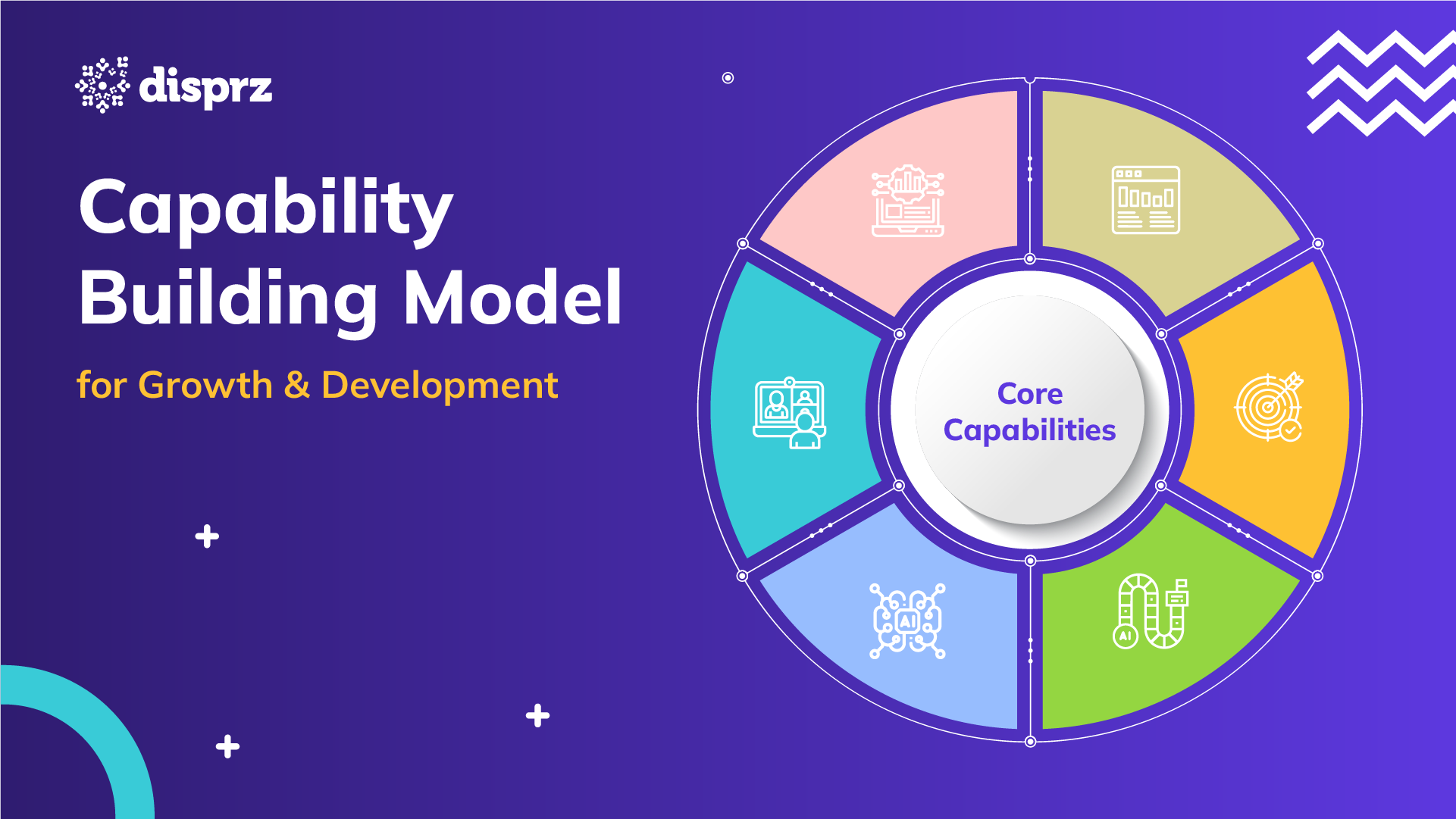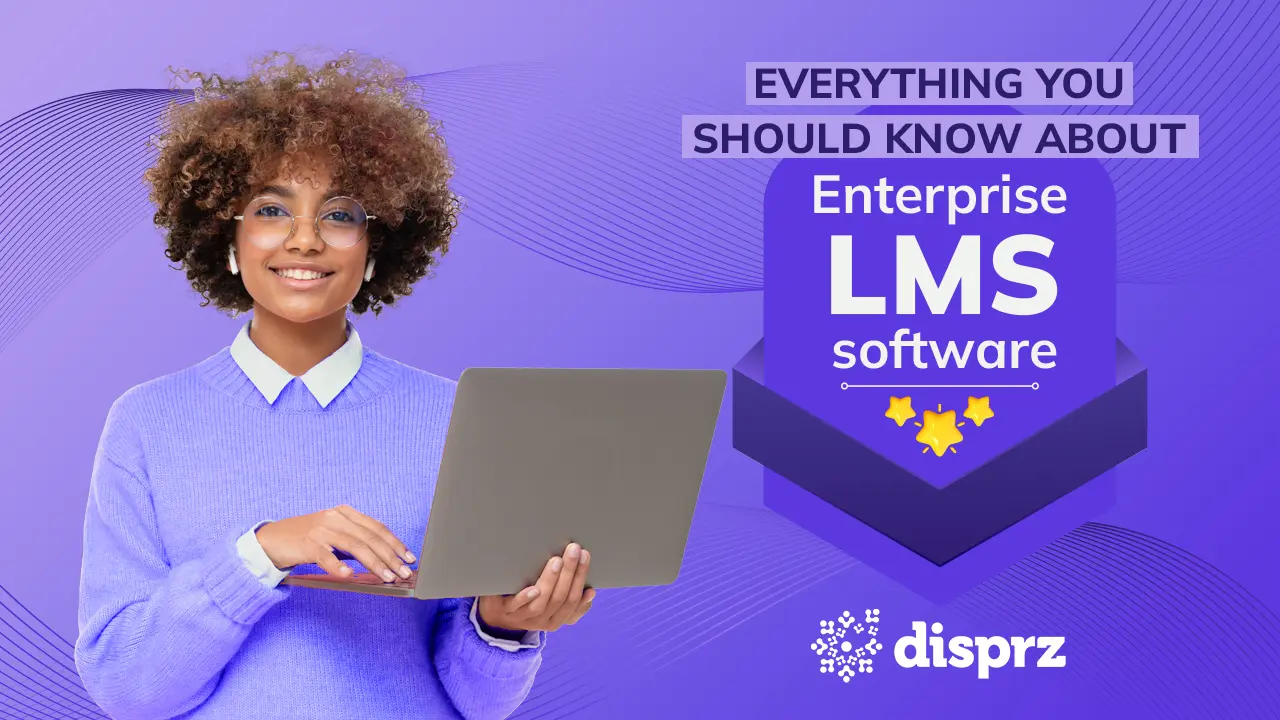
6 min read
• 21 May 2024
Shift to a Capability Building Model to Foster Employee Growth and Development
Explore the concept of capability building and its significance in fostering employee growth and development with Disprz.
-
eBookEmployee Upskilling - A Detailed Blueprint For Building A Skills-Driven Learning Culture
Digital disruption and rising customer expectations have made capability building extremely important for the long-term growth of a business. Companies that recognize the value of capability building have been able to map impactful learning journeys for addressing capability gaps. This allows their frontline and knowledge workforce to invest time in learning and development for building new capabilities.
Demand for new skills led to a 70% increase in average learning hours for frontline workers. While knowledge workers have invested more time consistently in upskilling since March 2020.
Currently, the market is filled with uncertainty and competition. Capability building is a great strategy to prepare your employees for the unforeseen future
What is Capability Building?
Capability building, also referred to as capability development, is the process of developing and enhancing the skills, knowledge, and abilities of individuals or organizations. These enhancements allow your workforce to effectively perform tasks, achieve objectives, and adapt to changing circumstances.
Capability building involves the acquisition of new competencies, the improvement of existing skills, and the cultivation of a mindset that embraces continuous learning and improvement.
Importance of Capability Building for Organizations
Capability development empowers individuals to enhance skills, fostering career growth and organizational success through a skilled, adaptable workforce.
Facilitate better performance and productivity: Equips employees with necessary skills, leading to increased productivity, improved outcomes, and enhanced customer satisfaction.
Enable faster innovation: Empower employees to identify opportunities, propose innovative solutions, and adapt to changing circumstances, fostering a culture of innovation and adaptability.
Attract and retain talent: Internal mobility resulting from capability building initiatives contributes to higher retention rates and makes the organization more appealing to skilled professionals.
Build a framework for succession planning: Identifies and nurtures potential leaders, ensuring a smooth transition of key roles and promoting stability during leadership transitions.
Align employees with organizational goals: Enhances capabilities to directly support strategic objectives, facilitating the execution of strategic initiatives and driving organizational success.
Competency vs Capability
Competency and capability are related but distinct concepts in the context of employee skill development and performance.
Competency refers to the specific knowledge, skills, and attributes that an individual possesses to perform a particular role effectively. Competencies are often defined and categorized within organizations to set expectations for job roles and guide employee development. For example, communication skills, problem-solving abilities, or technical expertise can be considered competencies.
On the other hand, capability has a broader scope and encompasses the overall capacity and potential of individuals or organizations to perform a range of tasks and adapt to various challenges. Capabilities include not only the existing skills and knowledge but also the ability to acquire new competencies and respond to changing circumstances. It is a more encompassing concept that looks at the bigger picture of an individual’s or organization’s potential.
Top 5 Capability Building Strategies in 2024
1. Model from the Top Down
Senior leaders should actively engage in capability-building programs, setting the precedent for the rest of the organization and promoting confidence in new initiatives. Their visible involvement encourages adoption and fosters a culture of continuous improvement.
2. Build from the Ground up
Effective capability building requires engagement from all levels of the organization, emphasizing the importance of fostering a culture of active participation and empowerment. By enabling employees to champion ideas and providing support and recognition, organizations can yield substantial improvements in their performance.
3. Engage a Critical Mass
To ensure success, widespread engagement in capability-building efforts is essential, as direct involvement not only influences individuals but also triggers a ripple effect throughout the organization. McKinsey suggests reaching a tipping point by directly engaging at least 25% of the workforce, emphasizing the importance of broad participation for optimal outcomes.
4. Embrace remote technology
Leverage remote collaboration tools to democratize capability-building efforts, transcending geographical barriers and enabling direct engagement with employees worldwide. Remote technology facilitates interactive training sessions, coaching, and process dissemination, fostering a culture of continuous learning and recognition.
5. Make small changes
Start with small changes, such as improving meeting efficiency, to boost productivity and accountability, recognizing the value of addressing fundamental processes for effective organizational transformation.
How to Develop a Continuous Capability Building Model?
Employee engagement is undergoing a metamorphosis. Over the last five years, disruption based on digital technologies has been phenomenal and unprecedented. It is time to review and reboot your employee experience strategy.
Developing a continuous capability-building model involves creating a structured framework that promotes ongoing learning, skill development, innovation, and adaptation within your organization. Here are the most important steps you must take when developing a capability-building model:
1. Identify Organizational Goals
You must start by understanding the long-term objectives and strategic priorities of your organization. Identify the key capabilities required to achieve those desired outcomes. This will provide a clear direction for your capability-building initiatives.
2. Conduct a Skills Gap Analysis
Assess the current skills (both hard skills and soft skills) and competencies of your workforce against the desired capabilities. Identify the areas where there are skill gaps or areas that need practice, change, or improvement. This analysis will help you prioritize the focus areas for your capability building program.
3. Define Learning Objectives
Based on the skills gap analysis, establish specific learning objectives for each capability. These objectives should be aligned with both your individual employee’s growth and the organizational goals.
4. Design Training and Development Programs
Develop employee training programs to address the skill gaps. Ensure that each training program is designed to provide continuous learning for your employees and drive organizational change.
5. Provide Learning Resources and Support
Offer a range of learning resources and insights to support continuous capability building. This may include access to relevant books, articles, online resources, and learning platforms, like an LXP. Create a supportive environment that encourages your employees to seek continuous improvement and knowledge, share best practices, and collaborate with their colleagues.
6. Encourage Skill Application and Feedback
Learning is most effective when it is applied in practical situations. Provide your employees with opportunities to apply their newly acquired skills in real work scenarios. Encourage feedback and reflection on their performance (including feedback from leadership), and provide constructive guidance for additional improvement.
7. Establish Measurement and Evaluation Metrics
Develop metrics and evaluation criteria to assess the effectiveness of your capability-building model. Track the progress of your individual employees and the overall impact on organizational performance. This will allow you to effectively identify areas of transformation and areas that need further improvement.
8. Foster a Learning Culture
You must cultivate a culture that values continuous learning for every employee. To effectively build a strong culture and positive mindsets, your managers and leaders must lead by example and actively participate in capability-building initiatives. You must also recognize and reward employees who demonstrate a commitment to learning and skill development.
Examples of Individual Capability Building
Individual capability development enhances employees' skills, knowledge, and confidence in doing their own jobs while also contributing to a growth attitude.
Challenges and KPIs: Setting goals for employees to grow their talents and helping them achieve them.
Training: Personalized or group training to improve an individual's skills in a certain field, such as marketing or time management.
Peer to Peer Learning: The exchange of best practices between coworkers, which may be self-organized or encouraged by the company.
Mentoring and Coaching: Providing personalized, one-on-one, expert advice to help individuals handle a specific difficulty or gain advanced professional abilities.
Examples of Individual Organizational Building
Organizational capability building encompasses the entire enterprise, resulting in organizational change and business transformation. It includes but is not limited to
Hiring New Expertise
Recruiting individuals with the necessary skills and expertise to assist in the organization’s future ambitions; these new staff can also be employed to upskill existing employees.
Strategic Upskilling
To entrench more efficient working techniques throughout the organization, and teach a critical mass of people with the same abilities.
Leadership Development
Providing new managers with a consistent approach and skill set for managing personnel and leading change.
Team Building
Developing stronger, more functional teams to improve working relationships, cooperation, and outcomes.
Process Improvement
Evaluating and upgrading procedures for improved operational efficiency and performance, standardizing and implementing common processes and best practices.
Risk Management
Anticipating and preparing for various business risks in order to assure continuity in worst-case circumstances.
IT Investment
Redesigning processes around new technology to boost efficiency and productivity, as well as better planning and measuring through data and analytics.
Blending Capability Building Models with Employee Experience
The very concept of the Learning Management System was giving learning a digital makeover — learning that was more engaging, more pull-based, more retention-focused, and convenient in the form of self-paced content. Until late, the LMS was a cornerstone in corporate training & employee learning agility. These platforms were hugely successful in equipping employees with their necessary skills, but soon reached a point of saturation.
Organizations felt a need to go beyond the LMS, and in came Learning Experience Platforms — with new features such as MOOC integrations, Open content from the web, On-demand learning, and AI Content recommendations.
At this stage, the employee development & corporate learning market is big. But the most successful companies in this segment are those that have taken a leap one notch higher — toward the Learning Experience platform.
The future of corporate workplaces is one such integrated capability-building platform that delivers constant employee experiences from hire to retirement.
About the author

Srinaagu Edla
Sri is a seasoned leader with a rich and diverse career spanning over a decade across IT, E-learning, L&D, and Fintech. His forte lies in consultative selling, consistently exceeding sales targets, expanding market presence across various geographies, and cultivating strategic partnerships. With a remarkable track record of launching Disprz in the USA, Europe & APAC markets, Sri is currently driving the company's growth and expansion in USA, dedicated to empowering organizations with innovative, performance-enhancing learning solutions.
More Resources
Sign up to get free resources and stay up to date with Disprz!
Discover how Disprz can align learning and upskilling with your desired business outcomes.






